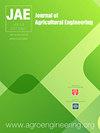Comprehensive Characterization of Cocos nucifera Palm Residues for Biochar Production
IF 2.4
4区 农林科学
Q2 AGRICULTURAL ENGINEERING
引用次数: 0
Abstract
The feasibility of using Cocos nucifera palm residues such as shell, husk, leaflets, fronds, and rachis for biochar production was investigated. Biomass characterization such as proximate, elemental, biochemical, higher heating value, and thermogravimetry were analysed. The results showed that fixed carbon of coconut palm residues was in the range of 10.48% to 17.47%, with the shell being the highest. Carbon, hydrogen, nitrogen, and oxygen content of the residues ranged from 39.46% to 48.60%, 4.23% to 6.00%, 0.42% to 1.66%, and 44.98% to 55.28%, respectively. Among the residues, lignin content was found to be maximum in the shell biomass (29.31%) and minimum in the rachis (21.89%). Thermogravimetric analysis of coconut palm residues revealed the presence of three stages of thermal degradation with overall weight loss ranging between 68.56% and 77.08 per cent. Higher fixed carbon and lignin content unveiled the potential of coconut palm residues for biochar synthesis. Slow pyrolysis of coconut palm residues resulted in biochar generation with fixed carbon content ranging between 65.40% and 78.21%, and proved its suitability for applications such as solid fuel, adsorbent, catalyst, and precursor for biomaterials production such as activated carbon and carbon molecular sieves.椰子树棕榈残渣生物炭综合特性研究
研究了利用椰壳、椰壳、椰叶、椰叶和椰轴等棕榈残渣生产生物炭的可行性。生物量的表征,如近似值,元素,生化,高热值和热重分析。结果表明,椰树残渣的固定碳含量在10.48% ~ 17.47%之间,其中椰壳的固定碳含量最高。碳、氢、氮、氧含量分别为39.46% ~ 48.60%、4.23% ~ 6.00%、0.42% ~ 1.66%和44.98% ~ 55.28%。其中,木质素含量在壳生物量中最高(29.31%),在轴生物量中最低(21.89%)。热重分析表明,椰树渣存在三个阶段的热降解,总失重率在68.56% ~ 77.08%之间。较高的固定碳和木质素含量揭示了椰树渣合成生物炭的潜力。通过对椰树残渣的缓慢热解,可制得固定碳含量在65.40% ~ 78.21%之间的生物炭,可作为固体燃料、吸附剂、催化剂以及活性炭、碳分子筛等生物材料的前体。
本文章由计算机程序翻译,如有差异,请以英文原文为准。
求助全文
约1分钟内获得全文
求助全文
来源期刊

Journal of Agricultural Engineering
AGRICULTURAL ENGINEERING-
CiteScore
2.30
自引率
5.60%
发文量
40
审稿时长
10 weeks
期刊介绍:
The Journal of Agricultural Engineering (JAE) is the official journal of the Italian Society of Agricultural Engineering supported by University of Bologna, Italy. The subject matter covers a complete and interdisciplinary range of research in engineering for agriculture and biosystems.
 求助内容:
求助内容: 应助结果提醒方式:
应助结果提醒方式:


